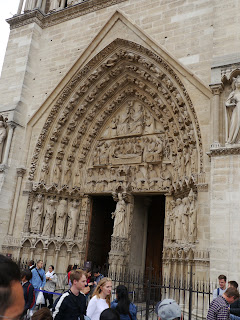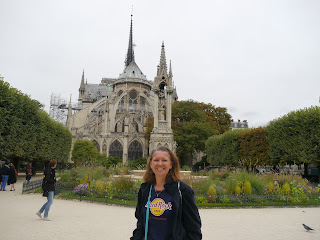During the French Revolution the statues were taken down and the heads were cut off. The cathedral was used as a warehouse and was left in ruins. Hard to imagine.
I was about five minutes late for Roman's tour, but fortunately he was still wearing his trademark pink vest and was still near the starting point, so I was able to join them. This tour is more academic than the other tours. While a similar length (75 minutes) it pretty much just walks three-quarters of the way around the cathedral. A lot of time was spent studying the front. There are a lot of details in the front. You see three doors (trust me, only is hidden behind me in this picture), each with an arch. Looking closer, each door is different. Having been built over two centuries, architectural styles changed. Add to that, it was renovated in the 18th century, things change. Roman emphasized nothing is on the cathedral by accident or randomly. It all serves a purpose.
Start with the two towers. They are not exactly the same because only God can make things perfect and this is a human creation.
The Rose window (in the center) at 9 meters wide (nearly 30 feet) was the largest one built by the 1240's or 1250's. According to Anglian Home, it is actually 12.9 meters (42.3 feet) wide and is the largest in the world. Perhaps I misheard. The circle is a symbol of the spirit and heaven; the box around it is the limited symbol of flesh and earth; and the two together symbolizes Mary holding Jesus. The architects wanted people to have a mystical experience with this church. I'm not an art historian, but it sounds nice to me.

Back in the early days of the cathedral, it was painted. I know it is hard to imagine. The brick path represents where walls to the shops and houses were hundreds of years ago.

 Back to the doors. There are three of them. The one on the right (when looking at the cathedral) is the plainest. It is also the earliest one. The statues are from ancient times and told stories people knew in that time. Many people were not
Back to the doors. There are three of them. The one on the right (when looking at the cathedral) is the plainest. It is also the earliest one. The statues are from ancient times and told stories people knew in that time. Many people were not literate in the Middle Ages. Statues were a way to preserve faith stories. The right does are the ones now used to enter the cathedral.
 We spent a lot of time looking at the center doors as they are currently not used regularly. They are very ornate. Jesus is in the center (just below the arch) and is opening the graves on judgement day. The angels are blowing trumpets. The belief in the Middle Ages was everyone waited until the end of time "and all the dead shall wake up to face judgment together." Individuality was not a concept, unlike today where Christians believe we go to heaven as soon as we die. Four architects worked on this door. The left side represents people going up to paradise. On the left people are going to Hell (if you are that interested, I trust you can find better close up images). In the middle is St. Michael. Jesus is above all sitting on the throne. When this was built, Jesus's and his blood were in Paris. The relics were destroyed during the French Revolution. The crown of thorns is still here and is visible on the first Friday of every month. Above Jesus is heaven with the saints.
We spent a lot of time looking at the center doors as they are currently not used regularly. They are very ornate. Jesus is in the center (just below the arch) and is opening the graves on judgement day. The angels are blowing trumpets. The belief in the Middle Ages was everyone waited until the end of time "and all the dead shall wake up to face judgment together." Individuality was not a concept, unlike today where Christians believe we go to heaven as soon as we die. Four architects worked on this door. The left side represents people going up to paradise. On the left people are going to Hell (if you are that interested, I trust you can find better close up images). In the middle is St. Michael. Jesus is above all sitting on the throne. When this was built, Jesus's and his blood were in Paris. The relics were destroyed during the French Revolution. The crown of thorns is still here and is visible on the first Friday of every month. Above Jesus is heaven with the saints. In the statues is Judas holding the purse to show the evils of man. There is also a headless statue representing St. Denis of Montmartre. Under the saints, the seven deadly sins are on display. There were more sins in the Middle Ages. There is a small ladder representing the ladder of justice of the bishops. There was no centralized justice system in the Middle Ages. In those days you were tied to a pole until you confessed your sins. I wonder what I would confess to under a similar situation.
 The third door is Mary's Gate. When it was built the church was nearly 1,000 years old. Women were starting to be included in the stories. There were many powerful women in those days. Also in this archway Emperor Constantine is represented because he became a Christian. St. Denis is represented in this doorway holding his head. It is in the Flamboyant style.
The third door is Mary's Gate. When it was built the church was nearly 1,000 years old. Women were starting to be included in the stories. There were many powerful women in those days. Also in this archway Emperor Constantine is represented because he became a Christian. St. Denis is represented in this doorway holding his head. It is in the Flamboyant style.We stepped back to look at the church more as a whole. We talked about the history of church. In the beginning of the 1800's the building was in ruins. In 1831 Victor Hugo was commissioned to write a story about the church called Notre Dame de Paris, which is the basis of the Disney movie The Hunchback of Notre Dame. It inspired people and made the building trendy. In the 1840's and 1850's it was renovated. A few decades later during the French Revolution it was destroyed. The line of kings was beheaded. An architect, at great risk to his own life, gathered the fragments and hid them. They were recreated after the war based on drawings and descriptions (no photography in that era). Where there were blanks, he improvised using modern styles. The statues of Adam and Eve have a Classic Greek (and not Gothic) style.
 The chimeras (they are not Gargoyles) did not exist in the Middle Ages. The statues did not exist, therefore Quasimodo could not have talked to them.
The chimeras (they are not Gargoyles) did not exist in the Middle Ages. The statues did not exist, therefore Quasimodo could not have talked to them. Thirty years ago when I was a student in Paris Notre Dame was covered in black grime. It was painstakingly cleaned off, using toothbrushes in some parts.
We walked across the street to see the Cathedral from a different angle. There is a plaque saying on August 19, 1944 the Parisians freed themselves from German occupation. Something they are still (and rightfully) proud to share. Bullet holes are still visible in buildings. Not as many as in Berlin, but something we don't tend to see in the United States.
We received our local information on finding someplace to eat. We were told NOT to go to the 1387 restaurant (now closed) basis of the musical Sweeney Todd where dogs were turned into food, and the barber cut the throats of his customers to steal their money then sold their flesh as meat in his restaurant. This was during the Hundred Years' War when cannibalism was done to live. There is no proof, but the story persists.
We talked about the Vikings. A subject I know a little bit about thanks to our trip to Sweden the month earlier. The Vikings were famous for being enormous fighters, when they were ordinary-sized looters. The losers wrote the history in this case. The Vikings were fighting the Parisians, until the Parisians encouraged them to go south to Normandy.
 The spire is 96 meters tall. The original plan by architect Viollet-le-Duc called for two spires. Le Duc really wanted his image preserved for all eternity as a statue on Notre Dame. He was refused, but if you look closely towards the top of Notre Dame you see a figure in green looking at the spire while everyone else is looking at Paris. It is rumored that le Duc put himself into the architecture anyway. He claimed it was really St. (Doubting) Thomas, but it evidently bears an uncanny resemblance to le Duc's face.
The spire is 96 meters tall. The original plan by architect Viollet-le-Duc called for two spires. Le Duc really wanted his image preserved for all eternity as a statue on Notre Dame. He was refused, but if you look closely towards the top of Notre Dame you see a figure in green looking at the spire while everyone else is looking at Paris. It is rumored that le Duc put himself into the architecture anyway. He claimed it was really St. (Doubting) Thomas, but it evidently bears an uncanny resemblance to le Duc's face.
I found more notes about Notre Dame. The Gothic style was invented in France. The pointed window style is symbolic of pointing to God, but it is also more stable. It shifts the weight along the walls, therefore the walls can be higher, keeping with the Gothic quest for height. The walls are 80% stained glass. The flying buttresses give the cathedral stability, as well as looking cool. These are some of the first flying buttresses in the world.
Ile de la Cite (where Notre Dame is located) used to be one of the most crowded places to live. Parisians used iron in their brideges and buildings (think of the Eiffel Tower) to save space.
There are two rose windows inside. The one on the North tells the story of the New Testament (N=New). The ones on the South tell the story of the Old Testament. This was done because at the time 90% of the population was illiterate, plus masses were told in Latin. This was a way to continue the faith traditions of the bible and the saints from father to sons. Life revolved around religion. People celebrated their Saint Day (some still do). If I were Catholic (I'm Presbyterian) a quick google search does not bring up a cool saint for my birthday. I've never heard of the dozen or so choices.
The Gothic Cathedral was viewed as a pure act of faith and gave a reason to believe in God. Take that sentiment with a grain of salt.

There I am with Notre Dame de Paris behind me. I wearing my Notre Dame de Lawrenceville jacket. I had nice weather on this trip, but September in Paris still calls for a jacket.
Some interior pictures (not part of the tour):
 |
| A history lesson |










No comments:
Post a Comment